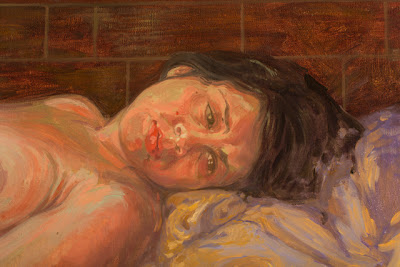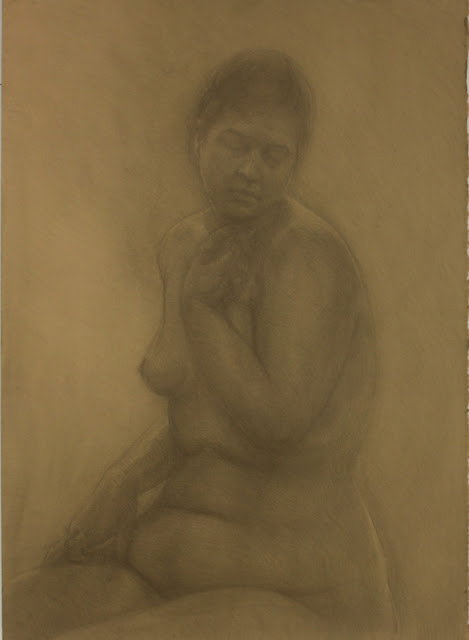.jpg) |
| Bacchus Comforting Ariadne. Oil on linen. 64x44in. 2013 |
Throughout my final semester, I continued to pursue my interest in still life and pattern, which was reawakened through working on Judith and Holofernes. I was trying to address the disconnect between viewer and subject – to allow the figures to be more absorbed in each other and more natural – surrounded by objects that appear to be contemporary. I readdressed my color palette, and began to work with a slightly cooler, more chromatic palette, focusing on swelling fields of color more than the localized color forms. I recognized a disconnect between all of the objects in my narratives and attempted to create a sense of atmosphere that was more attainable in my smaller drawings from life.
At this point, I also became interested in working from life with other figures, and began to make portraits of other people to extend my character vocabulary, and build my interest in other body types. I hope to pursue this side project in conjunction with my invented narratives until I reach a point where the two bodies of work seamlessly correlate into one.
 |
| The Soprano. Graphite on Paper. 22x30in. 2013 |
My last semester and my ASE exhibition are dedicated to pursuing a large, consecutive narrative project. I was interested in the story of Ariadne: her narrative allowed for a piece on abandonment and another on redemption. I wanted to explore how one figure could react differently in varying spaces and situations.
Ariadne, the daughter of Minos and half-sister of the Minotaur, watched as her father subjected fourteen youths to be slaughtered to the Minotaur. She fell in love with Theseus, one of the intended sacrificial victims. Ariadne gave Theseus a ball of golden thread – to guide him in and out of the maze – and a sword – to slay the Minotaur. In exchange Theseus promised to marry Ariadne.
.jpg) |
| Ariadne Abandoned by Theseus. Oil on linen. 56x52in. 2013 |
My first image addresses Ariadne abandoned on the island. I wanted to describe her reclined on a temporary bed of linens, either just realizing her abandonment or calming down from the first wave of terror at her betrayal. I wanted her to feel trapped – as if she is inhabiting the maze from which she rescued Theseus. Her reclining figure is abutted by a dark wall, shaded by plants, as if a solid gray field is keeping her from extending far into the interior of the image – she is trapped. The serpentine, flowing movements of the fabrics turn into waves, carrying small boats away from the shore – mirroring Theseus in his abandonment by sea. The entire shape of the figure mirrors the small boats that surround it, perhaps signifying Ariadne's correlation to the empty vessels surrounding her.
 |
| Ariadne Abandoned by Theseus. Graphite on paper. 40x44in. 2012 |
I wanted to stray from the literal image of a tiny boat leaving on the horizon, and chose a more metaphoric, and symbolic approach to the narrative. I became really interested with still-life objects during the creation of this composition, pulling meaning from the toy boats, ships in bottles, and bottled messages that would never be read. I wanted to address solitude and the inability to communicate, so the idea of sending out messages that may never reach their intended audience resonated well with this narrative. I wanted to have some semblance of the past presence of Theseus, a ghost acting as a character who no longer occupies the space. An old glove, holding the golden thread, represents the hand that once inhabited it and reminds us that the occupant of the glove was once present, but has since departed.
 |
| Ariadne Abandoned by Theseus. Pastel on paper. 20x30in. 2013 |
In the painting of Ariadne Abandoned by Theseus, I wanted to focus on creating a new color scheme. I was reaching out and attempting to forge connections with the contemporary art world through any venue available to me. I tried to stray away from local color. I began with a pastel color study, focusing on blending of series of colors to create color harmonies within shapes as well as between them, in an attempt to work less locally.
I changed my entire color palette, noting the pigments in each pastel I used, and then purchasing a new set of oil colors. I put away all of my cadmiums and began my work. I began using a stand oil – based medium, working out the entire composition in underlaying colors and reworking the final color composition on top of the contrasting hues. This allowed me to create more variation in the fabric and skin tones, to stray away from modeling with one or two colors in order to build volume.
 |
| Ariadne Abandoned by Theseus. Detail |
As the painting reached relative completion, I began to question the pose of the figure. I repainted each feature, hoping to give it more character, to take away some of the classical Idealism that was inherent in the pose, and create a more personal Re-Idealized form. I appreciated some of the figure's languid qualities, but wanted to bring it away from a posing model to a more reactionary figure.
I also questioned the relative lack of use of the upper quadrant of my painting. I decided to introduce another version of the golden thread. Ariadne was known as the weaver – some say that she is Arachne and the spider originates from her name. I wanted to symbolize the idea of Ariadne giving up her power to Theseus. She gave him her golden thread, and as he, the new spider, spun her web and left on the boat, Ariadne, represented by a bird, is left trapped in the golden spider web that she once controlled.
 |
| Ariadne Abandoned by Theseus. Detail |
I wanted to create a distinction between the two compositions – Ariadne Abandoned by Theseus and Bacchus Comforting Ariadne – and I decided that more emphasis needed to be placed on the arrangement of figures on the page. The painting was almost completed, yet I added a second panel to the bottom to extend the space, and remove the figure from its role as a centralized focal point. This change will make the figure feel trapped towards the top of her composition, allowing for a differing feeling and atmosphere from the second composition.
The ambiguity of the Ariadne drawing was a very positive turn in my work, but I noted that there was still a stage-like presence to the composition. I wanted to change this with the second half of the consecutive narrative.
Ariadne is not left to grieve her solitude for too long, as Bacchus, the god of wine, sees her and is amazed by her beauty and stoic nature. He comforts the weeping Ariadne and later marries her.
Bacchus Comforting Ariadne. Oil on linen. 18x12in. 2013
|
the viewer take on the role of Ariadne, empathizing with her in that moment. I chose to keep the same setting as the first composition but flipped the viewpoint and orientation. We are no longer seeing Ariadne as if we are watching her on a stage in a theatre, rather, we are floating over the couple, and gravity forces us to interact with them.
The symbols that were so vital to Ariadne in the first composition are scattered and folded into a discarded bit of fabric on the lower right. Bacchus is present, and the symbols that represented Theseus are no longer vital to the narrative. I wanted to focus on the gestures and absorptive qualities of the figures – I wanted them to be individuals, yet to feel like they are part of each other. A dark pelt sets off the light of Ariadne's skin yet helps to connect her to the relative darkness of Bacchus's bending form.
I continued to add elements that resonate with the contemporary audience. The arrangement of hair and less classical pose, especially of Bacchus, as well as his boxers and black socks help ground the figures. The fresh stripes of the mattress deflect from some of the classical features in Ariadne's reclining form.
.jpg) |
| Bacchus Comforting Ariadne. Detail |
_____________________________
In my journey through this collection of narratives, I have come closer to grasping the origin of my imperative to create these complex and frequently tiresome compositions. I am searching for an understanding and empathy for my characters and continue to explore different venues of attaining just that.
I recognize my love for the human form and for creating narrative compositions and continue to seek parallels between my work and the world in which I reside. I fail to give a final justification for my





































